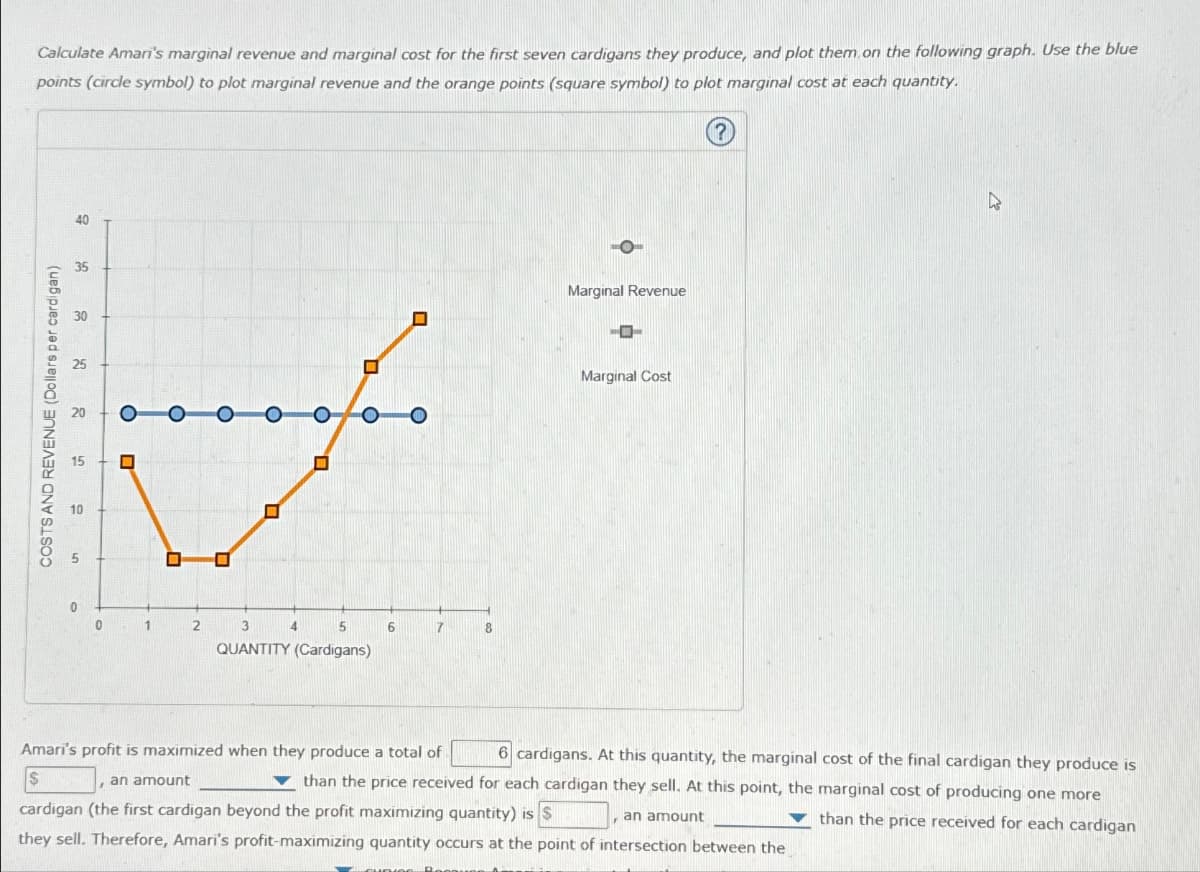Calculate Amari's marginal revenue and marginal cost for the first seven cardigans they produce, and plot them on the following graph. Use the blue points (circle symbol) to plot marginal revenue and the orange points (square symbol) to plot marginal cost at each quantity. 30 25 COSTS AND REVENUE (Dollars per cardigan) 10 15 35 40 0 2 3 4 5 6 QUANTITY (Cardigans) Marginal Revenue Marginal Cost Amari's profit is maximized when they produce a total of $ an amount . 6 cardigans. At this quantity, the marginal cost of the final cardigan they produce is than the price received for each cardigan they sell. At this point, the marginal cost of producing one more cardigan (the first cardigan beyond the profit maximizing quantity) is $ than the price received for each cardigan they sell. Therefore, Amari's profit-maximizing quantity occurs at the point of intersection between the D an amount Back to Assignment Attempts Keep the Highest / 33. Profit maximization using total cost and total revenue curves Suppose Amari operates a handicraft pop-up retail shop that sells cardigans. Assume a perfectly competitive market structure for cardigans with a market price equal to $20 per cardigan. The following graph shows Amari's total cost curve. Use the blue points (circle symbol) to plot total revenue and the green points (triangle symbol) to plot profit for cardigans for quantities zero through seven (including zero and seven) that Amari produces.
Calculate Amari's marginal revenue and marginal cost for the first seven cardigans they produce, and plot them on the following graph. Use the blue points (circle symbol) to plot marginal revenue and the orange points (square symbol) to plot marginal cost at each quantity. 30 25 COSTS AND REVENUE (Dollars per cardigan) 10 15 35 40 0 2 3 4 5 6 QUANTITY (Cardigans) Marginal Revenue Marginal Cost Amari's profit is maximized when they produce a total of $ an amount . 6 cardigans. At this quantity, the marginal cost of the final cardigan they produce is than the price received for each cardigan they sell. At this point, the marginal cost of producing one more cardigan (the first cardigan beyond the profit maximizing quantity) is $ than the price received for each cardigan they sell. Therefore, Amari's profit-maximizing quantity occurs at the point of intersection between the D an amount Back to Assignment Attempts Keep the Highest / 33. Profit maximization using total cost and total revenue curves Suppose Amari operates a handicraft pop-up retail shop that sells cardigans. Assume a perfectly competitive market structure for cardigans with a market price equal to $20 per cardigan. The following graph shows Amari's total cost curve. Use the blue points (circle symbol) to plot total revenue and the green points (triangle symbol) to plot profit for cardigans for quantities zero through seven (including zero and seven) that Amari produces.
Managerial Economics: A Problem Solving Approach
5th Edition
ISBN:9781337106665
Author:Luke M. Froeb, Brian T. McCann, Michael R. Ward, Mike Shor
Publisher:Luke M. Froeb, Brian T. McCann, Michael R. Ward, Mike Shor
Chapter5: Investment Decisions: Look Ahead And Reason Back
Section: Chapter Questions
Problem 5.6IP
Related questions
Question

Transcribed Image Text:Calculate Amari's marginal revenue and marginal cost for the first seven cardigans they produce, and plot them on the following graph. Use the blue
points (circle symbol) to plot marginal revenue and the orange points (square symbol) to plot marginal cost at each quantity.
30
25
COSTS AND REVENUE (Dollars per cardigan)
10
15
35
40
0
2
3
4
5
6
QUANTITY (Cardigans)
Marginal Revenue
Marginal Cost
Amari's profit is maximized when they produce a total of
$
an amount
.
6 cardigans. At this quantity, the marginal cost of the final cardigan they produce is
than the price received for each cardigan they sell. At this point, the marginal cost of producing one more
cardigan (the first cardigan beyond the profit maximizing quantity) is $
than the price received for each cardigan
they sell. Therefore, Amari's profit-maximizing quantity occurs at the point of intersection between the
D
an amount

Transcribed Image Text:Back to Assignment Attempts Keep the Highest / 33. Profit maximization using total cost and total revenue curves
Suppose Amari operates a handicraft pop-up retail shop that sells cardigans. Assume a perfectly competitive market
structure for cardigans with a market price equal to $20 per cardigan. The following graph shows Amari's total cost
curve. Use the blue points (circle symbol) to plot total revenue and the green points (triangle symbol) to plot profit for
cardigans for quantities zero through seven (including zero and seven) that Amari produces.
Expert Solution
This question has been solved!
Explore an expertly crafted, step-by-step solution for a thorough understanding of key concepts.
Step by step
Solved in 2 steps

Recommended textbooks for you

Managerial Economics: A Problem Solving Approach
Economics
ISBN:
9781337106665
Author:
Luke M. Froeb, Brian T. McCann, Michael R. Ward, Mike Shor
Publisher:
Cengage Learning

Managerial Economics: A Problem Solving Approach
Economics
ISBN:
9781337106665
Author:
Luke M. Froeb, Brian T. McCann, Michael R. Ward, Mike Shor
Publisher:
Cengage Learning